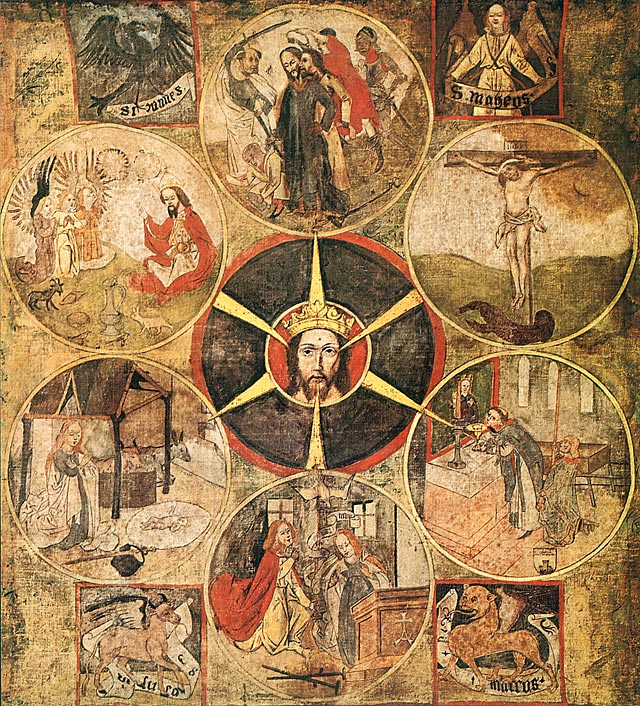
Wikipedia
You undoubtedly know that I have a particular love for Dr Jung, though you might wonder why I write from him now more often. That is because, on Facebook, I have recently, by some adorable friends, been upgraded! It might be not such great news, but at least it is a great encouragement for me to work it out. Of course, I have also noticed that it is not an as easy job!
The illustration above is a version that Brother Niklaus von Flüe had to have seen and got the image on the wall of his cell. “”The prototype of a mystic across religious-denominational divisions. Brother Klaus is “the only outstanding Swiss mystic by the grace of God, who had unorthodox primal visions and was able to look unperturbed into the depths of that divine soul, which still contains all denominations of mankind separated by dogmatics united in a symbolic archetype””. C.G. Jung: Brother Klaus. In: Neue Schweizer Rundschau, Neue Serie I/4 (1933), quoted from: On the Psychology of Eastern and Western Religion, Collected Works 11, § 487.
Jung said: “‘God’ is a primal experience of man, and from time immemorial, mankind has made an incredible effort to represent this incomprehensible experience, to assimilate it, through interpretation, through speculation and through dogma, or to deny it”. (C.G. Jung: Brother Klaus. Quoted from: Collected Works, 11, § 480.)
And Dr Jung, as he himself was an extraordinary visioner, mentioned this in his book, “Archetypes.” (Archetypen) He wrote:
What is meant by the archetype is clearly stated by its relation to myth, secret doctrine, and fairy tales just explained. On the other hand, things get more complicated if we try to understand psychologically what an archetype is. Research into myths has always been content with solar, lunar, meteorological, vegetation and other auxiliary ideas. The fact that myths are primarily psychological manifestations that represent the soul’s essence has hardly been accepted up to now.
Why is psychology the very youngest of the empirical sciences? Why hasn’t one discovered the unconscious long ago and raised its treasure trove of eternal images? Relatively simply not because we had a religious formula for all things of the soul that is far more beautiful and comprehensive than direct experience. If the Christian world’s vision has faded for many, the symbolic treasure troves of the East are still full of miracles, which can nourish the desire to look around, and at new clothes for a long time to come. Moreover, these images – be they Christian or Buddhist or anything else – are beautiful, mysterious and foreboding. Admittedly, the more familiar they are to us, the more frequent use has worn them down so that only their banal externality has remained in its almost meaningless paradox. The mystery of the virgin birth, or the Homoousian of the son with the father, or the trinity that is not a triad, no longer inspires philosophical imagination. They have become mere objects of belief. It is not surprising, therefore, if the religious need, the pious mind, and the philosophical speculation of the educated European should be drawn to the symbols of the East, to the grandiose conceptions of divinity in India, and to the abysses of Taoist philosophy in China, as the mind and spirit once were the spirit of ancient man has been caught up in Christian ideas. There are many who first gave themselves over to the influence of the Christian symbol until they became entangled in Kierkegaardian (Kierkegaard) neurosis, or until their relationship to God, as a result of an increasing impoverishment of symbolism, developed into an intolerably acute “I-Thou” relationship, then to succumb to the magic of the fresh strangeness of Eastern symbols.
It is not enough for the primitive to see the sunrise and set. Still, this external observation must at the same time also be a mental event, i.e. the sun in its transformation must represent the fate of a god or hero who, basically, is nowhere dwells differently than in the human soul…
What I mean is probably best illustrated with the example of a Swiss mystic and hermit, the recently canonised Brother Niklaus von Flüe. Probably his most important experience was the so-called Trinity Vision, which engaged him so much that he painted it or had let it paint on the wall of his cell.
The vision is depicted in a contemporary painting preserved in the parish church of Sachseln: It is a mandala divided into six, the centre of which is the crowned face of God. We know that Brother Klaus used the illustrated booklet of a German mystic to research the nature of his vision and tried to bring his primal experience into a form he could understand. He dealt with that for years. This is what I refer to as >editing< the icon. His reflections on the nature of the vision, influenced by the mystical diagrams of his guide, necessarily led to the conclusion that he must have seen the Holy Trinity himself, that is, the >summum bonum<, eternal love itself. The clarified representation in Sachseln also corresponds to this.
That is an abstract or summary of C. G. Jung; “Archetypen; Urbilder und Wirkkräfte des Kollektiven Unbewussten. (Archetypes; archetypes and influential forces of the collective unconscious.)
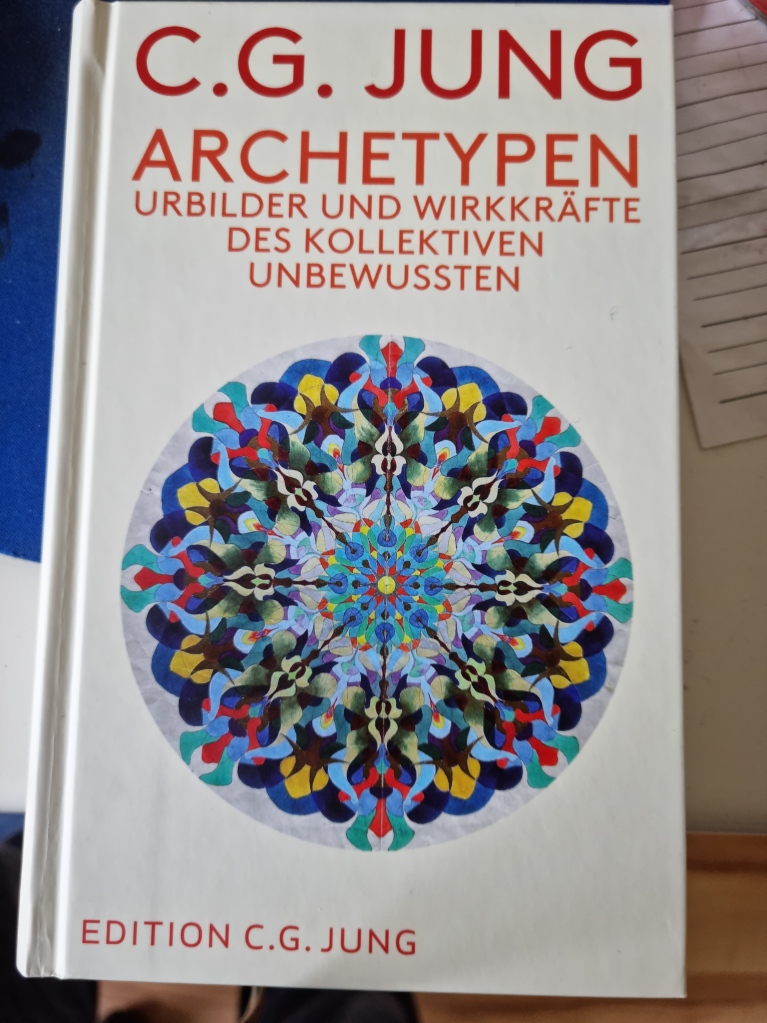
I will surely come back more on this. 💖🙏
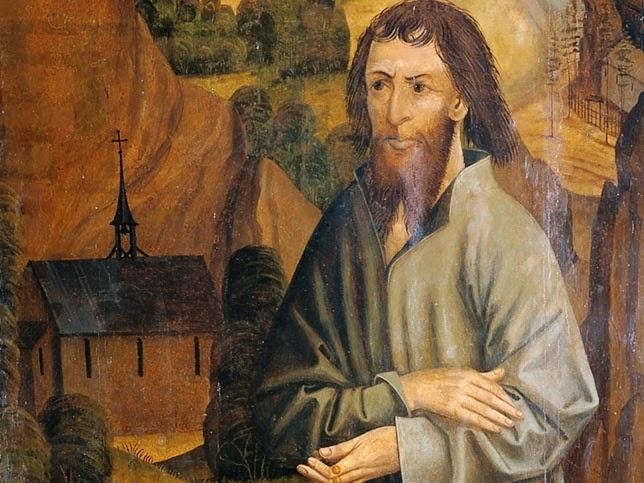
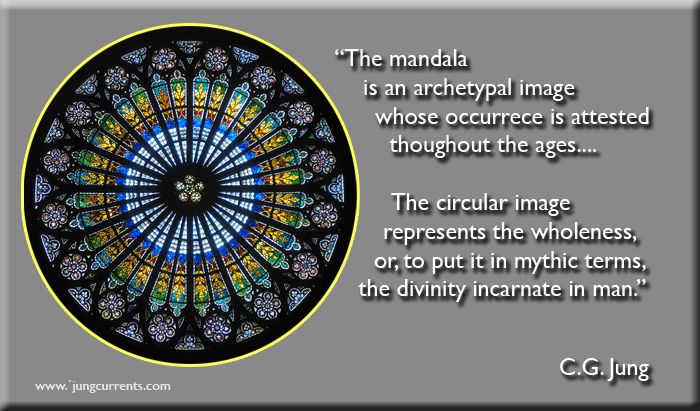
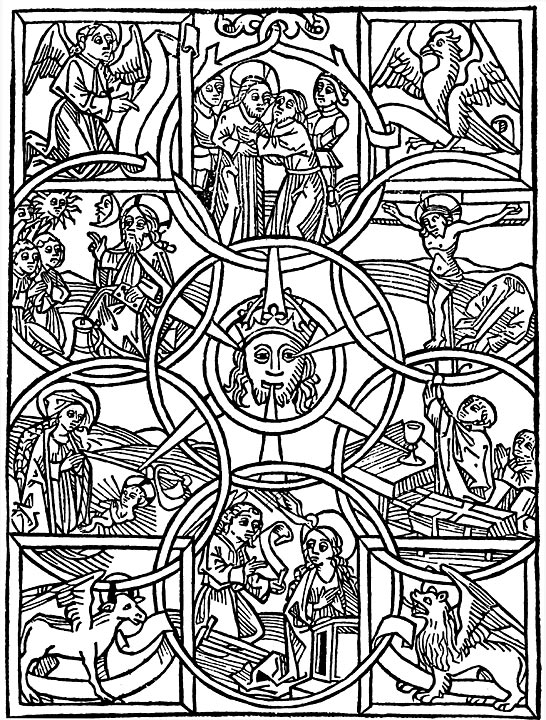
I can’t pretend to have followed all the narrative, but the images thus inspired are amazing.
LikeLiked by 2 people
Oh dear, you could imagine then how I had to bear the load to get the translation! By the way, I agree with you. Actually, as I have noticed, the translated Jung’s works in English are easier to understand. I think it is because they try to make it simple. I had to translate it from the original; German; therefore, I had some sweating moments. However, you are much appreciated. 🤗🙏💖
LikeLiked by 3 people
An amazing accomplishment! 👏👏👏
LikeLiked by 2 people
🙏🤗🙏🤗💖💖😘
LikeLiked by 1 person
I don’t know what it means to be upgraded on FB. Maybe you’re now an administrator of a group?
I believe we lived the archetypes through our religious life and close connections with Nature in the past. We have to seek this out now. My mythology class is studying Sophia as one the last strong images of the Goddess in Western religion–and She was more and more diluted by Christianity, especially the Protestant Church. Looking back to the Wisdom traditions, we see Her power and know She is still there waiting to emerge again. I love the image of Sophia in the main cathedral in Kiev.
I’m grateful for all I’ve learned about archetypal realms in my spiritual and practical life from Dr. Jung. Thanks for this rich post.
LikeLiked by 2 people
Agreed! Sophia is and reminds a symbol of wisdom. Thank you, dearest Elaine. Oh yes, I am an administrator of two groups and moderating some others 🤪 it’s encouraging and in the same way exhausting! Anyway, the brain must work 🤣🤗🙏❤️
LikeLiked by 1 person
Sounds like a neat class! You encourage me to read more about the Goddess, Sophia. It occurs to me that Jung used Sophia to describe the most developed stage of man’s “anima” psychic complex, which he theorized. In this stage man is believed to be in his most harmonious relationship to women, and life in general. Development according to the Dr. is as follows: Eve –> Helen –> Mary –> Sophia. The equivalent archetype of “Sophia” for woman’s animus he simply called “The Guide”. I believe…
LikeLiked by 1 person
An excellent translation Aladin! I always remember that English is your “third” language after Persian and then German. I mention this because as a lazy brit (I speak for myself only here!) I often struggle when reading Carl Gustav Jung especially when there are no images to bring the words and descriptions to life. Congratulations on your new Admin status. Love and light, Deborah.
LikeLiked by 3 people
Thank you, Deborah, my lovely friend. I am absolutely agreed with you! Reading Jung is really a challenge. I have a feeling that he thinks as in the same time writes 🤣 anyway, nice to see and feel your presence 🤗🙏❤️
LikeLiked by 1 person
Congratulations on the translation and also on the upgrade on Facebook.
I always find your posts very interesting, even if sometimes they are a bit complex
Thanks for all the research you do and the effort to tell us about something we don’t know well, at least as far as I’m concerned🙏🤗🙏
LikeLiked by 1 person
Congrats my friend. If you explain, we will understand all this better. I think we are all looking for God.
LikeLike
I wish I were a speed reader, Aladin. There are so many books I want to read and such a small amount of time to fit them into.
LikeLiked by 1 person
Oh, my dear. You are talking from my heart! I companion you in this matter thoroughly. You know? As I watch my bookshelf, I wish I could be able to read books like robots!! 🤓😂 Of course, I don’t offer this book for reading because it is in german! I’m just trying to translate from German and share some parts of Dr Carl Jung’s books. 🤗🙏💖
LikeLiked by 1 person
That’s amazing that you are reading it in German and translating! I’m in awe of those who are bilingual. I forgot most of my college Spanish. 🙄😂
LikeLiked by 1 person
Aha! 😮 Then I will tell you that I am trilingual! It is also Persian to add! 😂✌🙏💖😘
LikeLiked by 1 person
Congrats on your Facebook group upgrade, and this wonderful translation👏 Reading this, and seeing your images of the “Mandela,” ☀️🌼 especially the colorful one on the book cover, I am reminded of all of the ways the Mandela can be a symbol of life – For example, the rising and setting of the Sun, which you mention here. and how about MUSIC!? For example, a musical octave is a circle of tones. We start on the root note and climb. Every 7 steps up the ladder we reach the same note but on a new, higher frequency🎹 (C-D-E-F-G-A-B-C)
LikeLiked by 1 person
Do, re, me, fa, sol, la, si, Do. Well done, mate 👏 👍 👌 🙏🤗
LikeLiked by 1 person